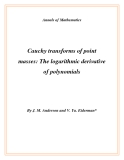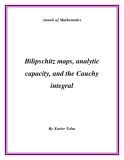
Cauchy transforms
-
Obviously, (1.2) implies the same estimate for M(Z(QN, P)). It was suggested in [2] that in this case the (1+logN) term could be omitted at the cost of multiplying by a constant. The above suggestion means that in the passage from the sum of moduli to the modulus of the sum in (1.1) essential cancellation should take place. As a contribution towards this end the authors showed that any straight line L intersects Z(QN, P) in a set FP of linear measure less than 2eP−1N. Further information about the complement of FP under certain conditions on {zk} is obtained in [1].
 21p
21p  noel_noel
noel_noel
 17-01-2013
17-01-2013
 42
42
 8
8
 Download
Download
-
Let ϕ : C → C be a bilipschitz map. We prove that if E ⊂ C is compact, and γ(E), α(E) stand for its analytic and continuous analytic capacity respectively, then C −1 γ(E) ≤ γ(ϕ(E)) ≤ Cγ(E) and C −1 α(E) ≤ α(ϕ(E)) ≤ Cα(E), where C depends only on the bilipschitz constant of ϕ. Further, we show that if µ is a Radon measure on C and the Cauchy transform is bounded on L2 (µ), then the Cauchy transform is also bounded on L2 (ϕ µ), where ϕ µ is the image measure of µ by...
 63p
63p  noel_noel
noel_noel
 17-01-2013
17-01-2013
 65
65
 7
7
 Download
Download
CHỦ ĐỀ BẠN MUỐN TÌM















